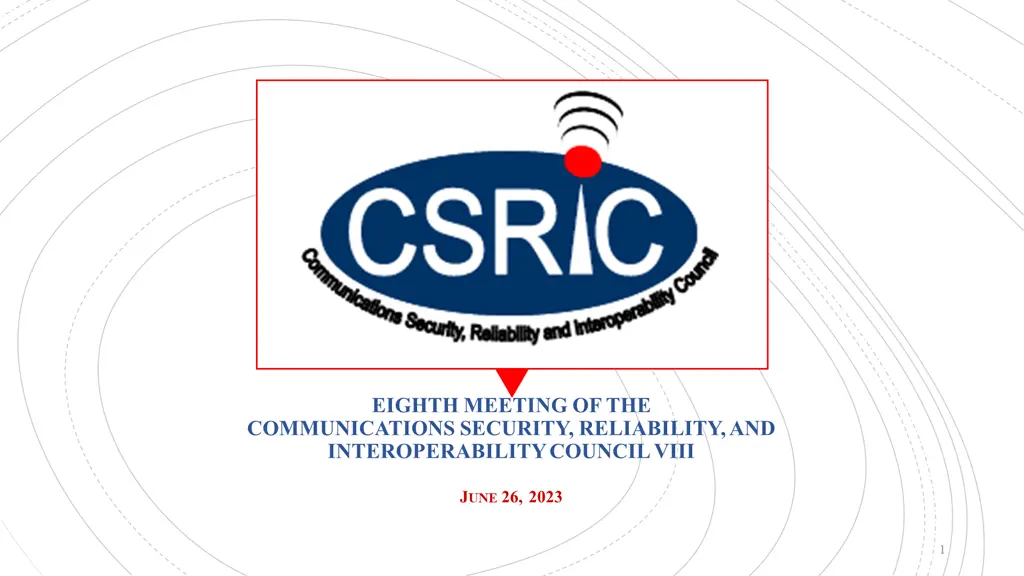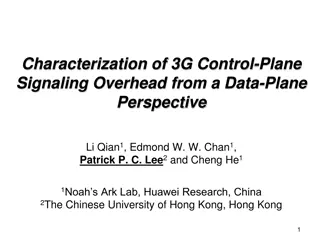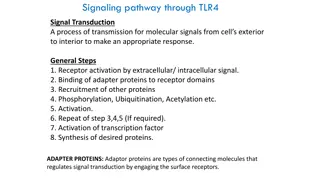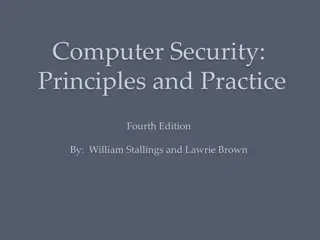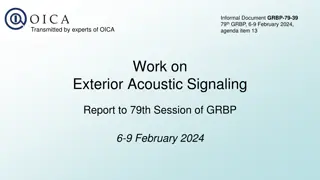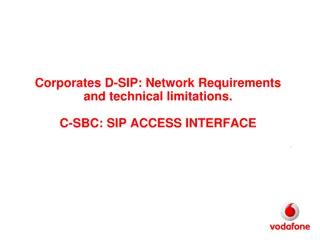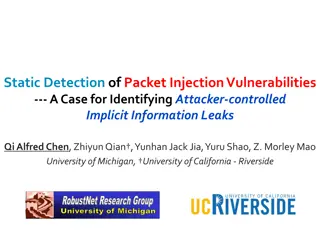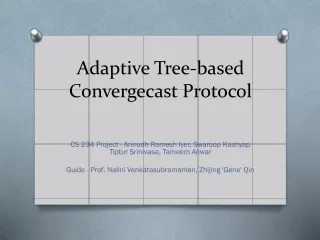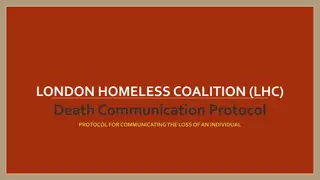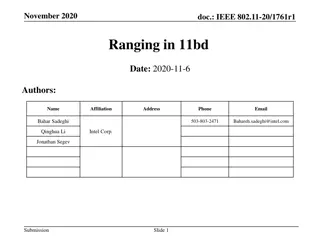Addressing 5G Signaling Protocol Vulnerabilities
The 8th meeting of the Communications Security, Reliability, and Interoperability Council to discuss and address security vulnerabilities in the newly adopted 5G signaling protocol, HTTP/2. Learn about potential risks, recommended safeguards, and the prevention of these vulnerabilities in the upcoming HTTP/3 protocol.
- Communications Security Council
- 5G signaling protocol
- security safeguards
- cyber threats
- network optimization
- denial of service attacks
Download Presentation

Please find below an Image/Link to download the presentation.
The content on the website is provided AS IS for your information and personal use only. It may not be sold, licensed, or shared on other websites without obtaining consent from the author. Download presentation by click this link. If you encounter any issues during the download, it is possible that the publisher has removed the file from their server.
E N D
Presentation Transcript
EIGHTH MEETING OF THE COMMUNICATIONS SECURITY, RELIABILITY, AND INTEROPERABILITY COUNCIL VIII JUNE 26, 2023 1
OPEN MEETING & WELCOME Suzon Cameron, DFO 2
OPENING REMARKS PSHSB Chief Debra Jordan, FCC 3
OPENING REMARKS CSRIC VIII Co-chair Nasrin Rezai, Verizon 4
PRESENTATION REPORTON REPORTON SECURITY VULNERABILITIESAND MITIGATIONSIN HTTP2 WG1: Co-chairs Brian Daly, AT&T Travis Russell, Oracle 5
Working Group 1: 5G Signaling Protocols Security June 26, 2023 Co-chairs: Brian Daly, AT&T Travis Russell, Oracle Communications FCC Liaison: Ahmed Lahjouji 6
Working Group 1: Background The Chairwoman of the FCC directs CSRIC VIII to examine and address security vulnerabilities associated with the newly adopted 5G signaling protocol, Hypertext Transfer Protocol Version 2 (HTTP/2), which, like the SS7 and Diameter signaling protocols considered in earlier CSRICs, is vulnerable to attacks. Researchers have discovered security issues related to the HTTP/2 protocol which could place millions of websites at risk of attack. CSRIC VIII will confirm these vulnerabilities and identify others, assess their potential for harm, and recommend safeguards to harden 5G networks and protect critical business and consumer data from these and other cyber threats. CSRIC VIII will also provide recommendations on how to remediate the risks associated with HTTP/2 and prevent them from carrying over to HTTP/3, the next release of the protocol. 7
Working Group 1: Objectives The FCC has learned of four main vulnerabilities and attack vectors related to HTTP/2: (1) slow read attacks, which call on a malicious client to read responses very slowly; (2) HPACK Bombs, which are malicious archive files designed to crash the program or system reading them and often disable antivirus software; (3) Dependency Cycle attacks, which exploit a new flow mechanism designed to optimize networks to instead create an infinite loop which cannot be escaped; and (4) Stream Multiplexing Abuse, which uses security flaws in stream multiplexing functionality to crash servers, resulting in a denial of service to legitimate users. We will research these as well as other vulnerabilities and attack vectors identified by industry through industry SMEs and WG member expertise. 8
Working Group 1: Members Co-chairs: Brian Daly,* AT&T Travis Russell,*Oracle Michael Bergman,* Consumer Technology Association Martin McGrath, Nokia Maureen C. Mclaughlin,* Satellite Industry Association Matt Carothers, Cox Communications Danny McPherson,* Verisign, Inc. Martin Goldberg,* National Security Agency Derek Peterson,* Wireless Broadband Alliance Angel V. Gomez, Verizon Communications Mitch Rappard, Palo Alto Networks Stephen Hayes,* Ericsson Mike Recchione, ATIS Jithin Jagannath, ANDRO Computational Solutions Christopher Wendt, Somos, Inc. Antwane Johnson,* FEMA Xiaoyang Lee, CISA John Marinho, CTIA FCC Liaison:Ahmed Lahjouji *Also a CSRIC VIII Member 9
Working Group 1: Alternates* Adam Barron, Verizon Communications Martin C. Dolly, AT&T, Inc. Carroll Gray-Preston, ATIS J. David Grossman, CTA Brandon Hinton, Satellite Industry Association Bradley Jackson, Verizon Communication Navin Jaffer, CISA Yong Kim, Verisign, Inc. Mark Lucero, FEMA John Mattson, Ericsson * Alternates are not a member of the Working Group and may not vote. 10
Working Group 1: Deliverables/Schedule WG virtual meetings (biweekly) Research/examine security vulnerabilities and attack vectors Report on Security Vulnerabilities in HTTP/2, submitted September 2022 Report on Best Practices to Mitigate Vulnerabilities in HTTP/2 and HTTP/3, being delivered today, June 2023 11
Executive Summary 5G is a departure from traditional wireless networks It is not the next evolution building on 4G 5G is a completely new architecture with new technology 5G is built using IT and cloud technology and not telecom technology The signaling protocol used within the 5G core network and other parts of 5G (such as OSS/BSS) is HTTP The network core uses HTTP/2 while some support systems may use HTTP/1 This raises concerns around known vulnerabilities in the HTTP protocol 12
Executive Summary The FCC tasked WG1 to identify any vulnerabilities 5G signaling vulnerabilities associated with the HTTP/2 protocol specifically The first deliverable is this report identifying those vulnerabilities The second deliverable is a report on how to mitigate those vulnerabilities and provide recommendations for both industry and the FCC 13
Methodology While there are many vulnerabilities in HTTP/2 for networks with public access (the Internet) these same vulnerabilities do not necessarily pose a threat in a closed network such as 5G This was taken into consideration as we examined all known vulnerabilities and explored other potential threats This report then identifies the vulnerabilities that pose a threat to 5G core networks rather than all vulnerabilities of HTTP The WG looked at existing industry sources, input from the FCC, as well as presentations from subject matter experts 14
References and Sources INDUSTRY SPECIFICATIONS 3GPP 28.533 Management and orchestration; Architecture framework 3GPP TR 29.893 Study on IETF QUIC Transport for 5GC Service Based Interfaces 3GPP TS 33.117 v17.0.0; Catalogue of general security assurance requirements IETF RFC 7540; Hypertext Transfer Protocll Version 2 (HTTP/2); May 2015 1. 2. 3. 4. INDUSTRY WHITE PAPERS The 3GPP defined Service Based Management Architecture White Paper (Nokia Bell Labs) QUIC and HTTP/3; Ericsson presentation, April 2020 1. 2. RESEARCHER CLAIMS HTTP/2: In-depth analysis of the top four flaws of the next generation web protocol; Imperva, Hacker Intelligence Initiative; August 2016, V1 Signalling Security Analysis: Is HTTP/2 Secure in 5G Core Network?; Hu, Xinxin; Liu, Caixia; You, Wei; Zhao, Yu; National Digital Switching System Engineering & Technological Research Center; Zhengzhou China HTTP/2: The Sequel is Always Worse; Kettle James 5G Network Slicing Security; McDaid, Cathal, AdaptiveMobile; Feb 2022 1. 2. 3. 4. We are very grateful to all the SMEs that presented to WG1. Your inputs were very valuable to our work. 15
Use of HTTP/2 in 3GPP Systems HTTP/2 has never before been used in 3GPP Standards-based systems Industry relied on proprietary signaling technology signaling system #7 (SS7) and Diameter (4G signaling) The 3GPP has specified that HTTP/2 (or later versions) be the signaling protocol of choice for future 3GPP systems The 3GPP has specified HTTP/2 for use in the Service Based Architecture (SBA) and the SBA Management Architecture (SBMA) defined in 5G and beyond The GSMA has also specified HTTP/2 be used between networks to support roaming The GSMA is also specifying the use of HTTP/2 in other parts of the network eSIM management interfaces use HTTP/2 The ORAN also uses HTTP/2 for orchestration and management interfaces 16
What is an SBA? In previous generations of wireless, the 3GPP system used point-to- point interfaces between network functions The network has become more dynamic with virtualization & more functions This has made such an architecture unmanageable The 3GPP defined the SBA in 3GPP TS 23.501 The SBA does not require the use of every network function for every mobile session a departure from previous generations of wireless This illustration also demonstrates the increase in network functions used by the network core within the SBA (next slide) The Service Communication Proxy (SCP) is not shown in this illustration but also serves a key role in the SBA architecture 17
What is an SBA? UDM NRF NEF NSSF NSACF NSSF NEF NRF PCF Nudm Nnrf Nnef Nnssf Nnsacf Npcf Nnssf Nnef Nnrf N32 vSEPP hSEPP Nnsacf Nsmf Nausf Namf Nsmf Npcf Naf NSACF AMF SMF SMF AUSF AF PCF Nnssaaf N4 NSSAAF DN N9 UPF UE N6 N3 (R)AN UPF N9 N9 VPLMN HPLMN The protocol specified for use between each network function is HTTP/2 HTTP/2 is the lowest version of HTTP allowed to be used in the SBA There is no access from the outside Internet into the SBA using HTTP 18
What is SBMA? Prior to 5G, the management system consisted of two functions An element manager A network manager A reference point was then identified between the two functions (ltf-N) Management interfaces were then defined for ltf-N Starting with 5G, the architecture was changed to align with a service- based architecture 19
What is the SBMA? The SBMA is comprised of mgmt services Configuration Performance Fault mgmt. New services are being added in subsequent releases of the specs Each 5G network function type has its own set of services This provides flexibility and allows suppliers to provide their own set of services for their NFs 20
Standardization of HTTP The IETF defines the specifications for the Hyper Text Transfer Protocol (HTTP) The protocol was developed for internet users to access and retrieve website information There have been 4 iterations of HTTP since its inception in 1991 HTTP/2 was released in 2015 as a major revision & replacement to HTTP/1.1 It provided better efficiency and reduced online latency HTTP/2 is defined in IETF RFC 7540 21
Standardization of HTTP HTTP/3 is still a work in progress HTTP/2 runs on TCP, which introduces latency issues within signaling Google has defined an adaptation layer called Quick UDP Internet Connections (QUIC) that emulates the connection-oriented features of TCP over a UDP connection UDP is much faster than TCP but uses best-effort to delivery (connection- less) but QUIC will resolve this issue HTTP/3 and QUIC has not yet been endorsed by the 3GPP for use in 3GPP networks There is still work to be done in the IETF The 3GPP continuously profiles the work of IETF and updates 3GPP specifications accordingly 22
Analysis of HTTP Vulnerabilities HTTP/2 supports a wide range of applications including the WWW, Internet, and specialized services (such as micro-services) The SBA/SBMA is one example of a specialized service While it is possible to use these known vulnerabilities researched by this CSRIC against any Internet connected entity, the 5G SBA/SBMA is not connected to the Internet, and is a closed network To gain access to the SBA/SBMA would require compromise of the network from within a company s resources This may be possible but is highly unlikely This WG1 provides recommendations to prevent insider threats in its final report 23
Assumptions: Analysis of HTTP Vulnerabilities The 1stassumption of WG1 is that the 5G core has deployed robust network perimeter defenses (between closed networks) around the SBA/SBMA functions The 2ndassumption is that these vulnerabilities would be second or subsequent stages in a multi-stage attack An earlier stage would be to compromise access to the SBA/SBMA This means that some of the vulnerabilities that we researched would not be applicable to a 5G network core, or have minimal impact 24
Overall Recommendations: While use of HTTP/1.1 may be common outside of the 5G core network, the known vulnerabilities associated with HTTP/1.1 suggest use of HTTP/2.0 or later versions of the standard is recommended for 5G signaling applications. For use in USA deployments, HTTP/2 is strongly recommended for cybersecurity reasons. HTTP/2 allows an option to implement clear text mode which enables trusted middle boxes to eavesdrop, modify, and inject HTTP requests and responses. This option is not intended to be used for signaling in critical infrastructure like 5G. HTTP/2 encryption is on a per JSON Packet basis providing integrity protection, where JSON packets with routing information can be sent with clear text mode, with the payload JSON packets being fully encrypted. HTTP/2 in 5G Core networks should use encryption and provide integrity protection. If and when 3GPP adopts HTTP/3, HTTP/3 mandates encryption and integrity protection based on TLS 1.3. Consistent use of authentication, encryption, and integrity protection aligns with zero- trust principles. 25
Overall Recommendations - continued: Further, this report assumes and recommends that proper security controls and best practices are in place to mitigate threats that may be internal to an organization to detect and mitigate risks and compromise to system credentials and unauthorized access. In terms of operational segmentation, the group also recommends that operational administrative systems and controls rely on dedicated consoles and not use generic or general purpose devices (e.g. Laptops or PCs) to access administrative and operational systems. Any laptop or PC used to access the Internet or email should never be used for accessing the 5G system. It is also recommended that monitoring and detection of NF deletion actions require proper escalation, review and approval prior to actual implementation of a deletion request. Given the automated nature of network scaling, this is best accomplished through AI mechanisms that detect multiple NF deletions and can prevent such an activity. 26
Client initiated attacks on servers This type of attack is initiated against HTTP/2 clients HTTP/2 servers Slow Read Attack, Slow Post Attack HPACK Bombs Dependency Cycle Attacks Stream Multiplexing Attacks URL Prefix Injection SBA customer attack Custom Headers Attack 27
Slow Read Attack This vulnerability was identified by the FCC as an example of vulnerabilities and included in the WG1 tasking Attacker sends valid HTTP requests to the server Attacker reads responses very slowly This keeps the connection alive without timing out This results in the server dedicating resources to the connection Eventually resources are overwhelmed or resources flooded with such requests blocking other requests from getting through This attack is not explicitly banned by RFC 7540 28
Recommendations: Slow Read Attack SEPP and SCP server implementations and network integration should consider: Server capacity: Upgrading capacity is a stopgap as an aggressive attacker can step up the attack rate to still overwhelm the increased server capacity, Reverse-proxy-based protection: This approach is can potentially intercept some of these attacks. A reverse proxy can rate-limit requests on a per-route basis, Timeout rules: A connection timeout heuristic can be determined on the statistics of other connections, Data rate rules: Enforce a minimum data rate, Pattern analysis: An intrusion detection and prevention system using patterns of requests can potentially identify malicious connections, and Non-specific DDoS mitigations: e.g. segmentation and monitoring. 29
Recommendations: Slow Post Attack The attack can be mitigated by: Establishing a minimum incoming data rate, Ignoring/Dropping any connections that have a rate slower than minimum, Setting an absolute connection timeout, and Rejecting or drop connections to HTTP methods that are not supported by the server, in order to drop POST messages which are not expected by the service. Note: SCPs / SEPPs cannot say if the target HTTP servers support the specific HTTP methods (and these won t be able to cache this info for each NF producer / NF consumer for callbacks/notifications). 30
HPACK Bombs This vulnerability was identified by the FCC as an example of vulnerabilities and included in the WG1 tasking RFC 7540 permits the sender to define the max size of the header compression table The RFC does not restrict the size of individual headers The attacker inserts a header field that is exactly the size of the HPACK dynamic header table in the dynamic header table The attacker than sends requests to expand the header field in the dynamic table repeatedly The attacks can quickly result in gigabyte-level storage rqmts on target machine The end-result is a DoS as the target servers resources are exhausted 31
Recommendations: HPACK Bombs The HPACK Bomb attack takes advantage of a server implementation that does not limit unpacked memory in response to requests using HPACK header compression. The mitigation is to set limits, either fixed or dynamic according to some heuristic. https://www.imperva.com/docs/Imperva_HII_HTTP2.pdf 32
Dependency Cycle Attacks This vulnerability was identified by the FCC as an example of vulnerabilities and included in the WG1 tasking RFC 7540 allows a stream to give an explicit dependency on another stream This allows the server to prioritize stream handling The dependency graph must be a strict tree processing a loop or cycle in the graph can cause unpredictable behavior (infinite loops, i.e.) The result is a DoS as the target servers resources are exhausted 33
Recommendations: Dependency Cycle Attacks There are two elements to mitigation: Prevent dependency cycles and prevent unlimited graph size. As noted in the original Imperva research, Nghttp2 restricts the dependency graph size to MAX_CONCURRENT_STREAMS. When a client tries to create a larger graph using priority frames, the server throws away old streams. https://www.imperva.com/docs/Imperva_HII_HTTP2.pdf However, the server implementation should also restrict dependency graphs to strict tree structure. 34
Stream Multiplexing Attacks This vulnerability was identified by the FCC as an example of vulnerabilities and included in the WG1 tasking An HTTP/2 stream represents a single request/response cycle Once the cycle is closed, RFC 7540 requires the stream identifier is not sued again over the same connection If an implementation of the HTTP/2 protocol stack on a server fails to follow this requirement, the result is a DoS The WG1 classified this as an implementation vulnerability, defined in section 6.1.7 35
Recommendations: Stream Multiplexing Attacks RFC7540 clearly states that for a given connection, Stream identifiers cannot be reused. In this vulnerability, a flawed implementation fails to observe this requirement consistently. The mitigation is therefore for implementations to follow the RFC in this detail. 36
URL Prefix Injection The value of the scheme header is meant to be HTTP or HTTPS but it supports arbitrary bytes Some protocol stacks (implementations) use it to construct a URL w/out performing validation This allows the attacker to override the path and possibly poison the cache or create a server side request forgery (SSRF) vulnerability While the RFC allows this, implementations lacking validation this vulnerability can be affective Since the specific 5G implementations are unknown this was considered as a protocol level vulnerability While this may not be an implementation vulnerability, it was included in the report for more thorough review and classification for the next report 37
Recommendations: URL Prefix Injection The mitigation is to perform data validation on all header fields received from the client, but specifically for the arbitrary data in the :scheme pseudo-header. The server should accept only http , https , or other specific character strings as may be required. The ALPN extension in TLS is also for this purpose, however if the actual :scheme is not as expected then it should be rejected. 38
SBA customer attack The following sequence illustrates this attack 1. Attacker compromises or takes control over a Session Mgmt Function (SMF) (consumer) and is now inside the SBA 2. The compromised SMF mounts an SBA DoS attack against the Universal Data Mgmt (UDM) (producer) using the slow read vulnerability 3. The 5G network operations degrade under this attack by the compromised SMF instance This attack requires earlier steps to compromise the SMF (insider attack) 39
Recommendations: SBA customer attack As stated previously and in the context of insider threats, the group recommends that operational administrative systems and controls rely on dedicated consoles and not use generic or general purpose devices (e.g. Laptops or PCs) to access administrative and operational systems. Any laptop or PC used to access the Internet or email should never be used for accessing the 5G SBA system. To reiterate the group recommends the monitoring and detection of NF actions and further require proper escalation, review and approval prior to actual implementation of functional changes to the network. 40
Heist Attack This attack is based on vulnerabilities in other protocols and implementation shortfalls because SSL/TLS does not hide the length of the clear-text message (a weakness that has been well-known to the security community since 1996) adversaries can directly infer the length of the response before encryption. With this information, the attacker can utilize the details of other protocols and web-browser activity including the handling of 3rdparty cookies to extract encrypted behavior More information and its applicability (as well as mitigation) on this type of attack will be provided in the final report 41
Recommendations: Heist Attack The following is the recommended mitigation for the Heist Attack. The 5G Core needs to be continuously scanned for: Port scans of the Operating System. A credential scan of OS may be performed on some NFs depending upon business requirements, and Application layer scan of Network Functions [both Virtual Network Functions and Containerized Network Functions]. Once an anomaly is detected, the following actions are taken: A ticket is generated for any vulnerabilities found from the scan, The Security Operations team contacts the vendor to confirm the vulnerabilities OR to make sure there aren t any false positives. If no false positives, then start planning to have a timeline to fix the vulnerabilities with the respective vendors, and Subsequent Lab testing of patch/point release updates that remedies the open scan vulnerabilities. 42
Custom Headers Attack In addition to the standard HTTP/2 headers, 3GPP has specified several custom headers that are specific to a 5G SBA. Some of these custom headers are defined for flow control and could be used by a compromised NF to slow or shut down critical functions within other NFs. https://ieeexplore.ieee.org/document/9952199 43
Recommendations: Custom Headers Attack Monitoring of NF functions is recommended to determine if a NF is compromised. The mitigation is to ensure that comprehensive monitoring capabilities are in place which can detect and notify the network operator about abnormal NF behavior and hence enable the execution of appropriate mitigation countermeasures e.g. isolate and remove the NF from live service. 44
Implementation Vulnerabilities Implementation issues do not implicate HTTP/2 systems in general, as do protocol issues. Recommended mitigation for implementation issues is a matter of upgrading to a version of the software provided by the product vendor that has a fix for the issue. When selecting vendors providing NFs to be used in the 5G system, those NFs should be tested and validated prior to deploying in the network. All NFs should be compliant with the 3GPP Security Assurance Specifications (SCAS) and its evolution for the specific NF. These vulnerabilities were not considered by WG1, as they are tracked through CVEs and fixed by each individual product supplier through patches it is outside the scope of WG1 45
Conclusions While the use of HTTP/1.1 may be allowed in some parts of the 5G ecosystem, the known vulnerabilities suggest the use of HTTP/2 or later should be standardized for all 5G signaling All service providers providing 5G services or maintaining 5G systems should ensure they have practiced the latest network hygiene and implemented the latest security best practices to prevent insider threats. FCC: If future evolutions of 3GPP standards make a determination to adopt the usage of HTTP/3 and QUIC, the FCC should consider future CSRIC efforts to study the use of HTTP/3 and QUIC in the context of 5G and future systems. FCC: A future CSRIC should research the security and vulnerabilities of APIs used within 5G networks, both within the core network or exposed outside the core network. 46
DISCUSSION REPORTON REPORTON SECURITY VULNERABILITIESAND MITIGATIONSIN HTTP2 WG1: Co-chairs Brian Daly, AT&T, Travis Russell, Oracle 47
CALL FOR VOTE REPORTON REPORTON SECURITY VULNERABILITIESAND MITIGATIONSIN HTTP2 WG1: Co-chairs Brian Daly, AT&T, Travis Russell, Oracle 48
PRESENTATION REPORTON RECOMMENDATIONSONTHE ROLE OFTHE FCC IN PROMOTINGTHE AVAILABILITY OF STANDARDSFOR 5G ENVIRONMENTOF VIRTUALIZATION TECHNOLOGY WG3: Co-chairs Micaela Giuhat, Microsoft John Roese, Dell 49
Working Group 3: Leveraging Virtualization Technology to Promote Secure, Reliable 5G Networks Co-chairs: Micaela Giuhat, Microsoft John Roese, Dell FCC Liaison: Jeff Goldthorp 50
